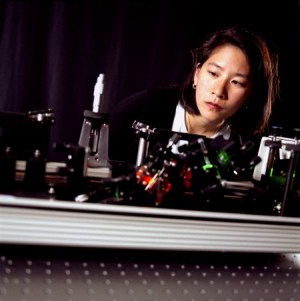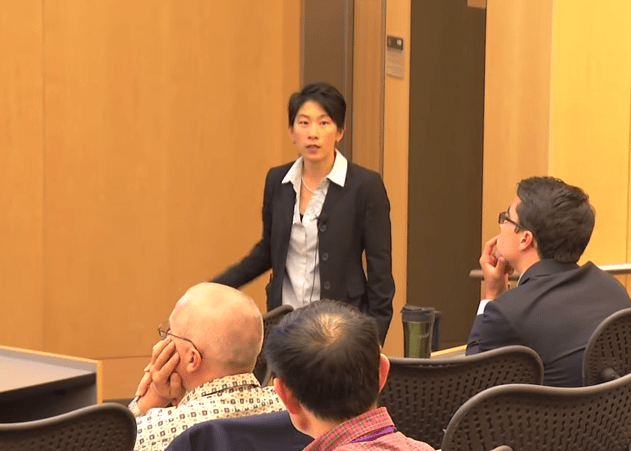BTN.com staff, BTN.com staff, May 24, 2015
A series that covers the true revolutionaries, Game Changers explores how innovators from Big Ten universities - students, faculty and alums - are inventing or reinventing their chosen fields.
 Scientists at Northwestern University have discovered what they believe to be the first liquid nanoscale laser. For those in the scientific community, it represents a potentially major breakthrough that could alter their fundamental understanding of how light functions on a nano scale.
Scientists at Northwestern University have discovered what they believe to be the first liquid nanoscale laser. For those in the scientific community, it represents a potentially major breakthrough that could alter their fundamental understanding of how light functions on a nano scale.
For the rest of us, it may be the most significant development in lasers since Dr. Evil harnessed them to his hench-sharks in the Austin Powers movies.
?Technologically, it?s a breakthrough,? said Dr. Teri Odom, a professor of materials science and engineering who headed up the research at Northwestern. ?Now you?re able to make lasers on the cheap that you can use in real time.?
One of the keys to this technology is being able to shrink the size of a laser or light source to make it comparable to an electronic wave. That allows scientists to turn it to what Odom calls a ?lab on a chip.?
The discovery is the culmination of a number of tests on the properties of the wavelengths. Odom said they went with what they knew and tested until they could fill in the blanks.
?We had done some previous work with dye molecules, and we mixed it with a polymer,? she said. ?It?s not a very elegant solution, but it worked. It turned out it worked out a lot better than we thought it would. Sometimes you have hunches about things. This is one of those instances. There should be ways to really push the boundaries. It turns out we could push the boundaries of potential.?
It could also fundamentally change the medical industry, streamlining it to proportions one could only dream about while sitting in the waiting room or agonizing for weeks to get lab results.
?If you need to go to the doctor?s office, they could handle all the diagnostics while you?re sitting in the office,? Odom said. ?Right now, you send in samples and it takes 24 hours to a few weeks. The idea is you need less material to do the analysis. It?s also more sensitive because the designed diagnostics on the chip make it easier to analyze. They are pretty advantageous.?
She said the goal isn?t to undermine the work medical professionals perform, but to streamline it.
?Everybody is working hard and they?re doing their best, but there?s always ways to make it more efficient,? she said. ?It?s a pretty good motivator. We?re all human beings, and we all have health issues.?
Odom and her team are now just beginning to realize the fruits of their labor, as their paper - titled ?Real-time Tunable Lasing from Plasmonic Nanocavity Arrays? - was published last month in the academic journal Nature Communications.
?It?s been really interesting,? she said. ?We?ve had a number of papers published in nature journals before. But this is the first time all three reviewers were enthusiastic about it. A lot of independent news sources picked it up. It?s nice when your students get recognized for the hard work that they?ve done.
?There?s a lot happening out there. To be able to break through is a good feeling.?
[btn-post-package]Odom credits Northwestern?s collaborative mindset for making breakthroughs like this possible. She said it took contributions from different groups, such as the chemistry department, to determine which types of lasers could be used.
?They?ve always encouraged collaborations,? she said of NU. ?It?s in our DNA. Recently everyone has been interested in multidisciplinary research. But the reason Northwestern has been ahead of the curve is we?ve been doing this.?
The team has just scratched the surface as to what can be done with the technology. She points to the work with nanotubes as an example of the discovery?s potential.
?I think the next several years are going to be very exciting for us,? Odom said. ?Once we?re able to design these nanotechnologies, the sky is the limit.?
She cites the architectural benefits with multi-scale polymers, as well as the endless possibilities in the medical field for instruments that could take the place of today?s MRI.
?We?re just in a fundamental stage, meaning we want to find what can we do to make it better,? she said. ?We?re also looking at new material. Now we?ve just been using molecules.?
And eventually, it could affect practical everyday tasks for the rest of us.
?We could make a mirror that is structured so that it doesn?t fog up after a shower,? she suggested.
Now that?s a million-dollar idea!
?You build upon things,? she said. ?You train great students and make it a nice environment, and you can do anything.?
By Matthew Wood








